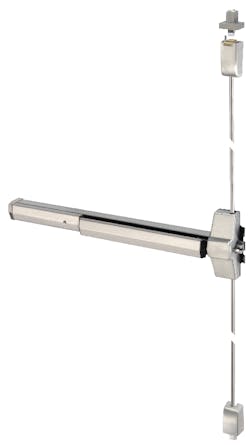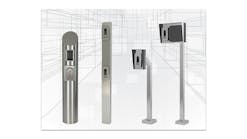Hurricanes and tornadoes have been wreaking their havoc in the United States since long before the states became united. But it’s relatively recent that strict codes have been established and window and door products tested and improved to help protect buildings and the people sheltered within them.
Today’s national hurricane codes provide guidelines for window and door opening solutions used in the construction of all buildings in hurricane-zone states, with individual states having some leeway to fine-tune their guidelines. The states utilizing hurricane codes include all those that touch the waters of the Gulf of Mexico (Texas, Mississippi, Louisiana, Alabama, Georgia and Florida) and all states along the eastern seaboard (from Florida to Maine).
Hurricane codes are designed to secure every exterior opening and maintain safe interior pressure – to make sure that every exterior opening can remain secure during a storm and keep wind, rain and debris from penetrating the envelope of the building. The codes cover a complete range of doors, windows and exterior components. For example, some of the Yale Locks and Hardware components offered as windstorm solutions include: square bolt panic bars, exit devices, 8800 mortise locks, 5300 and 5400 cylindrical locks, electrified mortise and cylindrical locks, and a number of different latches.
Andrew Brings New Windstorm Codes
The major turning point in the development of hurricane codes was Hurricane Andrew. In August of 1992, the 60-mile wide Andrew smashed into South Florida with gusts reaching 175 mph. It left a path of devastation throughout Homestead, Florida City and parts of Miami, then continued northwest across the Gulf of Mexico and hit the Louisiana coastline. The storm caused at least 40 deaths, directly or indirectly, and $30 billion in property damage. It was the costliest natural disaster in U.S. history at that time.
In the aftermath of Hurricane Andrew’s destruction, insurance companies threatened to drop coverage of storm-prone areas unless more stringent building codes were developed to prevent similar disasters. Building and construction experts sifted through the rubble to determine why some structures were obliterated by the high winds, while others remained intact. This follow-up investigation, coupled with existing wind engineering data, provided the basis for a new set of windstorm codes and testing standards that were adopted into the International Building Code.
The codes are based on the ASCE-7 standards and emphasize protection of the building envelope by requiring components, including doors and hardware that have passed a rigorous set of testing requirements. Products used in hurricane applications undergo the following tests:
- ASTM E330 Standard Test Method for Structural Performance of Exterior Windows, Doors, Skylights and Curtain Walls by Uniform Static Air Pressure Difference—Products tested to this standard are subjected to a force equal to 1 ½ times the design pressure for a duration of 10 seconds.
- ASTM E1996 Standard Specification for Performance of Exterior Windows, Curtain Walls, Doors and Impact Protective Systems Impacted by Windborne Debris in Hurricanes—Products tested to this standard must withstand impact from a nine pound, two-inch by four-inch piece of lumber shot from an air cannon at a speed of 35 mph.
- ASTM E1886 Standard Test Method for Performance of Exterior Windows, Curtain Walls, Doors, and Impact Protective Systems Impacted by Missiles and Exposed to Cyclic Pressure Differentials—This test is performed after the E1996 impact test and exposes the opening to cyclic pressures. The test starts at zero pressure and escalates up to the design pressure before receding back to zero. Flush openings must endure 900 cycles, while glazed openings are subjected to 9,000 cycles.
Changing Building Code Requirements
Since the nineties, hurricane codes have continually evolved, and building code requirements have been established, with global organizations like the International Code Council (ICC) revisiting existing safe construction standards and proposing new standards every three years. In addition to these international guidelines, individual states in hurricane zones can adopt their own guidelines for the construction and functionality of door and window products.
For years in the state of Florida, hardware and doors had to be tested together and meet safety standards as assemblies. Components could not be interchanged.
Today, swinging door assembly components Florida have to meet ANSI a250.13 testing standard, as established by members of the Steel Door Institute and Builders Hardware Manufacturers’ Association. This standard for “severe windstorm resistant components” allows components to be paired with different doors.
This could be changing soon, however; Florida organizations are developing a new (2013) building code that may return us to the previous assembly testing requirement. The point of this is that manufacturers must constantly anticipate changes to safety standards and be prepared to adapt their testing procedures and product certifications to these changes.
Tornado Codes
It was not until 2008 that new code requirements were established for the manufacture of tornado specialty hardware. Until that time, FEMA 361 had offered guidelines, but not serious structure, and had the focus on doors, suggesting a prescriptive standard like 14 gauge steel doors and frames and 3 points of latching and 3 deadbolts on doors. This changed with the tornado outbreak during the summer of 2007 that hit Wichita, KS and destroyed Greensburg, KS (with sustained winds exceeding 200 mph).
After this tornado onslaught, the communities in this area put tornado shelters in all of their schools, so there was a serious need for hardware that could be used every day for classroom doors that would double as shelter doors. The combination of the tragic event and subsequent need led to new national standard for tornado shelter, such as the ICC 500 2008 Standard for the Design and construction of Storm Shelters.
Hurricane vs.Tornado Products
The guidelines for the manufacture and testing of windstorm products are very different for hurricane and tornado protection. Testing procedures for both are designed to isolate, as much as possible, the loads and conditions to which a particular component is subjected during these events. However, in the case of tornado product testing, doors and window shutters are always tested together with the hardware with which they will be sold as a complete assembly.
The current standard hurricane test for Windstorm components features a 9 lb. 2x4 fired at a door at 35 mph, hitting the door with 350 ft. lbs. of force (simulating the force of 70 mph winds).
The Windstorm product testing for tornadoes is much more strenuous. The current tornado test for Windstorm products features a 15 lb. 2 x4 fired at a door at 100 mph, striking the door with 5000 ft. lbs. of force (and simulating the force of 250 mph winds).
Unlike hurricane building codes and test requirements, which zero in on the East and Gulf Coast states, Windstorm resistance guidelines for tornado assemblies focus primarily on states in the central region of the U.S., from Texas up to Minnesota and Michigan.
Also, while hurricane standards usually cover every building, residential and commercial, and every exterior opening, tornado standards only cover products used in tornado-resistant doors and window shutters in community shelters. These shelters could be located in a range of public buildings – but schools, hospitals, police stations and fire stations are the buildings usually incorporating shelters to protect occupants and our first responders.
Finally, most hurricane Windstorm products are standard products that have been modified to meet the guidelines (such as the use of welding instead of adhesives). Tornado products, on the other hand, are manufactured to be heavier and stronger than standard products. For example the hardened stainless steel in a Tornado Windstorm door strike is about four times thicker than a standard hurricane product. And shelter doors and shutters are usually secured with three points of latching as opposed to one or two unless, through testing, the single point or two point hardware is able to pass the severe testing requirements. This ensures that our door assemblies can meet tornado testing requirements, and they will pass repeated cycles of opening and closing without failure.
Finding the right Windstorm Product
Most companies provide Windstorm products that conform to the latest guidelines and codes. Even so, there are differences between the different manufacturers. Here are some things to consider:
- Not all Windstorm products are designed for tornado protection. In fact, many manufacturers don’t do tornado product testing at all. Make sure the products you buy address the needs of your specific Windstorm application. Also, if you need both tornado and hurricane products (as you might in a state like Texas), consider one company that has expertise in both areas and offers a full breadth of products.
- Not all product testing is the same (Part 1). Consider a company that does some initial R&D testing in-house. This can lead to a cost savings for the end-user, as it can save wasted steps and ensure that the right hardware is tested for the right applications. It also demonstrates that the company has in-house expertise, which can be very helpful when you need installation or design help.
- Not all product testing is the same (Part 2). It is an advantage for Windstorm products to feature independent third party certification. It’s not a code requirement (yet), but when product testing has been conducted by an organization like the American Testing Institute and features third-party certification, it should provide a higher level of security to architects and building officials. Products with a third-party certification “label” carry a metal tag or mark showing that they have been tested specifically for Windstorm applications.
- Does the company offer a wide range of Windstorm products including components that provide form as well as function? Some Windstorm products are offered with architectural-grade finishes, making them ideal for place like retail stores, movie theaters and other venues that call for performance and style.
- Are representatives from your company involved in the organizations that write and refine the Windstorm codes? If they are, these companies not only demonstrate a high degree of Windstorm product expertise and focus, but they also have a leg up on the latest testing standards and product developments.
As you can see, there are many things to think about when it comes to purchasing the right Windstorm solution for your building. But the primary objective is always the same: keeping the storm out of the building, and keeping the building and the people inside it safe from nature’s harshest elements.
Jim Bell is the Windstorm Coordinator for ASSA ABLOY Door Security Solutions.






